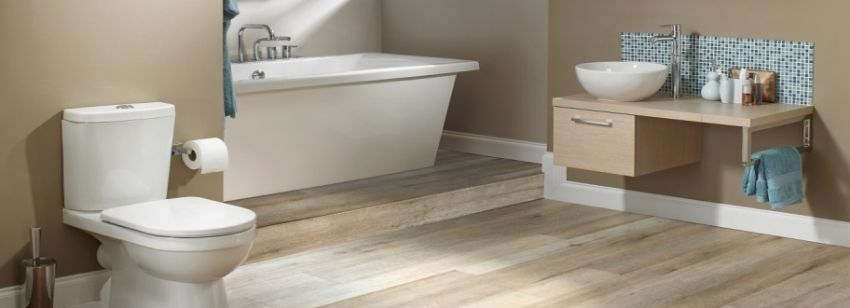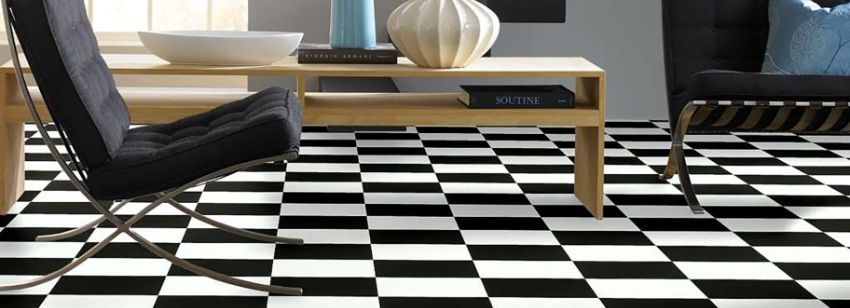Vinyl Floor FAQ: 20+ Things You Should Know
Vinyl flooring can be very tricky. After all, there are so many types of vinyl flooring, from LVP to sheets. That can be a lot of information and research to wade through. Fortunately for you, we can help!
By now, you probably know a thing or two about vinyl flooring, but there are still a few pressing questions on your mind. Guess what? We know the answers. We’ve compiled our most common questions to help make your shopping experience easier.
Let’s take a look!
By now, you probably know a thing or two about vinyl flooring, but there are still a few pressing questions on your mind. Guess what? We know the answers. We’ve compiled our most common questions to help make your shopping experience easier.
Let’s take a look!
The Basics: What is Vinyl Flooring?
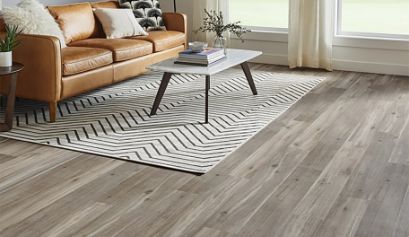
There are so many kinds of vinyl flooring: waterproof, peel and stick, sheet vinyl, and then all those acronyms. LVF, SPC, WPC. It can start to look like a jumble of alphabet soup. Let’s start with the basics so you know more about your options.
What is the difference between WPC, LVF, and SPC flooring?
WPC vinyl
This technically translates to wood-plastic composite vinyl flooring. However, many people also use the acronym to stand for waterproof core vinyl flooring. Both meanings are correct. WPC vinyl flooring is 100% waterproof, and its core is made from a composite of plastic and wood. In the flooring industry, it’s referred to as engineered vinyl flooring. WPC is recommended for residential use since it is softer underfoot.SPC vinyl
SPC stands for stone-plastic composite or stone-polymer composite. Both of these terms are used interchangeably. SPC is also sometimes referred to as Rigid Core luxury vinyl flooring. That’s because the stone-plastic composite core in this luxury vinyl is ultra-dense. Like WPC, SPC is 100% waterproof and is also called engineered vinyl flooring within the industry. SPC is great for both residential and commercial use.LVF vinyl
This is the acronym for luxury vinyl flooring. Luxury vinyl flooring is sort of the umbrella term that often encompasses WPC and SPC. LVF can also refer to vinyl that is not waterproof or rigid core, but that has a higher-quality visual, and usually a basic glue down or a lock installation mechanism.
What is LVP flooring?
LVP stands for luxury vinyl planks. These planks are made to be very durable, able to withstand high traffic, kids, and pets. Standard LVP consists of a vinyl core with a printed surface layer. It might have an attached underlayment, though not always, and it can either be glued down or floated with a locking mechanism. Some LVP is waterproof, with WPC or SPC cores.Though there isn’t a defined industry standard for what “luxury” flooring is, you should expect top-notch visuals (typically wood-look), and a thick wear layer to protect the surface from wear and tear.
What is LVT flooring?
LVT is another word for luxury vinyl tiles. Like vinyl planks, you should expect the best of the best out of LVT flooring. Luxury vinyl tiles can stand up to the challenges of a busy home with pets and lots of traffic.Luxury tiles are very durable and stylish, with high-quality, stone-look visuals, and even some realistic textures in some cases. More high-end LVT products will feature waterproof cores, attached underlayment, and a thick wear layer, though you won’t see these features with every single product.This is the acronym for luxury vinyl flooring. Luxury vinyl flooring is sort of the umbrella term that often encompasses WPC and SPC. LVF can also refer to vinyl that is not waterproof or rigid core, but that has a higher-quality visual, and usually a basic glue down or a lock installation mechanism.
What is the difference between LVP and LVT?
LVP is the acronym for luxury vinyl planks. LVP refers to the specific shape of the vinyl flooring shape – a plank. Luxury vinyl plank flooring often features a wood-look image and the plank format helps sell the look.LVT is the acronym for luxury vinyl tiles. Luxury vinyl tiles often feature a stone-look image and mimic natural stone flooring. Like LVP, LVT refers to the specific shape of the vinyl flooring– tile. These can come in different sizes but tend to keep the standard tile shape.
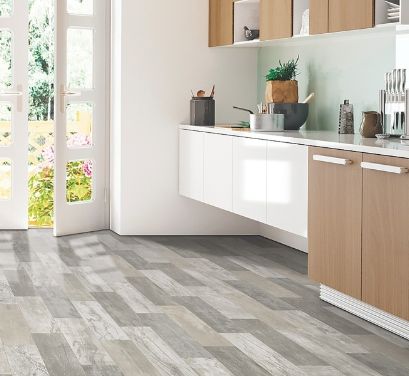
What is vinyl sheet flooring?
Sheet vinyl is a multi-layer, durable flooring that’s easy to install and easy to clean. A vinyl sheet features a wear layer and a wear layer to protect it from scuffs and scratches, much like vinyl planks and tiles.Vinyl sheets used to have a reputation for being “low-quality,” but those days are long gone. Popular sheet vinyl is made of quality materials and contains a fiberglass layer that lays the sheet flat and keeps it from curling. This fiberglass layer also allows sheet vinyl to be loose laid or installed using double-sided adhesive tape, instead of a more labor-intensive glue down installation.
Luxury vinyl sheets come with a huge range of stylish looks, including realist wood and looks, and more contemporary decorative surfaces. The best part? You get all of these benefits at an affordable price.
Are vinyl flooring and linoleum the same?
Vinyl and linoleum flooring are actually very different! At one time the only vinyl anybody knew about was sheet vinyl, which has an appearance fairly similar to linoleum. Because of this, a lot of people confuse the two. Here are the main differences between linoleum and sheet vinyl.Linoleum:
- Made of natural materials
- Anti-microbial
- Anti-static properties
- Needs to be sealed every year
- Requires a professional installation
Luxury Vinyl Flooring:
- Made of durable PVC
- Protective wear layer
- Backing options for fiberglass, foam, or felt
- DIY-friendly installation
- Virtually no maintenance
Use and Durability
Will my dog’s nails scratch vinyl flooring?
While some vinyl products do have a scratch-resistant surface, no vinyl flooring is 100% scratch proof. Over time, scratches may occur. We recommend trying to keep the dog’s nails trimmed to help lessen the number of scratches.
Can I put heavy appliances down directly on my vinyl floors?
You can put heavy appliances on vinyl tiles and planks as long as you use furniture pads or sliders under them. However, you should not install heavy appliances over loose laid sheet vinyl, because this could cause a pinch point and damage the floor.For furniture, you should use felt furniture pads under the legs to prevent scratching the flooring. Never use rubber, as rubber can stain vinyl flooring.
You can also put most vinyl flooring under kitchen cabinets and appliances, but it’s a good idea to glue down those sections.
Do I need a protector on my vinyl floor for my rolling desk chair?
Even though vinyl flooring has a tough wear layer, it’s a good idea to use a mat under desk chairs. Over time, rolling desk chairs might cause some wear and tear. It’s better to be safe than sorry!Can I put vinyl flooring in my basement?
All vinyl flooring can be installed in basements, though some options will be more difficult to install. For example, a vinyl sheet that needs to be glued down will take more effort than a click-lock vinyl plank. You’ll need to make sure the cement subfloor is completely level, or thin flooring like sheet vinyl could show the imperfections through the surface and actually become damaged over time.DIY-friendly waterproof vinyl flooring, like TritonCORE Pro, is a great option in basements. It can generally be installed in moisture-prone areas and even over uneven subfloors. If you’re installing waterproof vinyl flooring over basement concrete, we recommend adding a vapor barrier underneath.
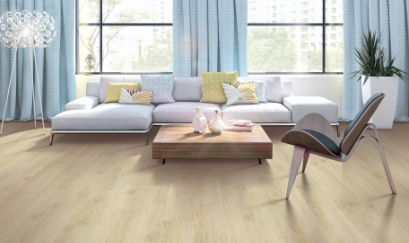
Can you install luxury vinyl flooring outdoors?
Even if using waterproof vinyl flooring, we do not recommend vinyl flooring for outside or semi-outdoor areas. UV rays can cause fading and weather can damage the flooring over time. Using vinyl flooring outside may also void the manufacturer’s warranty. For these reasons, stick to using vinyl flooring indoors.
Will vinyl flooring expand?
Some vinyl flooring like TritonCORE Pro will not expand and contract like other flooring types unless under extreme conditions. It is recommended to leave a small expansion gap around the perimeter for such extreme conditions, but the likelihood of expansion is very small. Not even flooding will cause waterproof vinyl flooring to expand. In fact, we tested this to prove our point.That being said, other luxury vinyl flooring without a waterproof core, or a rigid core, will expand and contract.
Installation
How do you install vinyl plank flooring?
Most luxury vinyl planks and tiles use a tongue and groove lock system. This is also known as click-lock flooring, and it’s easy to install on your own. There’s no tape, glue, or professional needed! When you install luxury vinyl this way, it’s called a floating floor, because it’s “floating” over your subfloor.Here is how to install interlocking vinyl flooring on your own. These tips apply to both planks and tiles:
- Start in a corner of the room, working from left to right. Set down the first plank (or tile), using spacers to maintain a 3/8” gap between the plank floor and the wall. This gives the floor enough room to expand and contract with temperature changes.
- Complete the first row. Insert the tongue of the second plank at an angle into the groove of the first. Once they click together, lower the second plank until flat. Use a tapping block and rubber mallet to gently tap the planks into a locked position.
- Continue until the first row is finished. When you come up to the wall and need to cut a plank, measure the plank, and cut it using a utility knife or a tile cutter.
- Begin the next row with the leftover cut end, as long as it’s at least 6” long. This will create a more natural staggered look.
- Set the plank into the previous row at a slight angle to ensure that it slides into place and interlocks correctly.
- Continue working across the room, ensuring that the planks are interlocked tightly. Use spacers every few feet around the edges of the flooring and remove them when the installation is complete.
How do you install fiberglass vinyl sheet flooring?
Fiberglass vinyl sheets can be installed with the loose lay method, meaning the sheet doesn’t need to be glued down. It’s incredibly DIY-friendly, and is best if you want temporary flooring, or are installing in a low traffic area.
Follow these steps to loose lay your new vinyl sheet in no time:
- Unroll the sheet, and line up the seams if you have multiple sheets. Ensure the sheet is square to the room and not crooked.
- Let the sheet acclimate to the temperature and humidity for at least a day before cutting it.
- Cut around walls and obstructions using a utility knife. Leave a 1/8” – 1/4” gap to prevent any bunching up or pinching if the sheet expands with temperature changes.
- If you want some extra stability, you can apply double-sided tape around the perimeter and under seams.
- Please note: With this install method, there can only be one major seam. Larger spaces that require more than two sheets will need to have the sheets glued down.
How do I cut vinyl flooring?
There are a couple of different methods for cutting luxury vinyl flooring, depending on the type.How to cut vinyl plank flooring:
LVP or WPC vinyl flooring can be cut by hand using a sharp utility knife; simply score the vinyl flooring and snap it apart for a clean break. SPC Vinyl flooring can be cut using a power saw, or even a tile cutter. The choice is up to you!
How to cut vinyl sheet flooring:
The best way to cut a vinyl sheet is to use a sharp utility knife and a straight edge to guide you. Cut the sheet to fit the edges of the room as well as around any obstacles like columns, leaving a 1/8” – 1/4” expansion gap. Before making any cuts, ensure that the sheet is square to the room. A crooked or skewed pattern would ruin the look of your new floor.
Which direction should you install vinyl plank flooring?
When installing vinyl planks, you should orient the length of the planks to parallel the longest walls in the room. This will make the space feel larger. If you have a square-shaped room, lay the planks out so the length follows the flow of traffic.Can vinyl planks or tiles be installed over radiant heat?
Yes, most vinyl planks and tiles can be installed over radiant heat. However, it’s a good idea to check manufacturer instructions before doing so.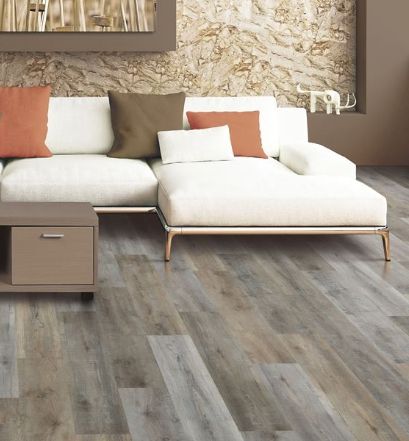
Can I install vinyl plank flooring over carpet? Over tile?
Vinyl plank flooring cannot be installed over any high pile carpet. The “squish” of a plush carpet will prevent vinyl planks from locking properly. However, if the carpet is a tight, low pile style, then thicker, tighter locking, vinyl planks may be suitable for installation.Some people have had success installing vinyl plank flooring by placing plywood over carpet. However, it’s always best to check manufacturer guidelines for these types of installations.
Vinyl plank flooring with attached underlayments, such as TritonCORE Pro or other luxury products, can be installed over existing tile flooring surfaces, provided that there are no major imperfections. Thinner sheet vinyl flooring is not recommended over tile, as telegraphing (an imprint from the subfloor on the main floor) may occur. Be sure to double-check with the manufacturer recommendations to be certain.
Do I need a vapor barrier?
If you’re installing over a concrete subfloor, a vapor barrier should be used. Vapor barriers should also be used when installing in moisture-prone areas. Be sure to double-check with the manufacturer recommendations to be certain.
Do I need an underlayment?
Some products have an underlayment attached, so you will not need to purchase additional underlayment with those products. At most, a vapor barrier will be needed in those installations.Typically, if there is no attached underlayment, you should purchase one. Underlayment has sound dampening properties, protects your subfloor and flooring, and makes your vinyl flooring softer underfoot. Cork and foam popular choices for vinyl flooring, because rubber will cause staining.
Cleaning and Maintenance
How do I clean my vinyl floors?
The good news is, vinyl flooring is virtually maintenance-free. It’s so easy to clean and take care of, you won’t dread doing chores.To clean your vinyl floors, be sure to vacuum up any dust, dirt, or debris. It’s best to use a vacuum without a beater bar for this.
You can also use a damp mop to keep your vinyl flooring clean. Be sure to clean up any spills immediately to prevent damage to your flooring.
That’s all it takes for clean floors!
How do I keep my gray vinyl flooring streak-free after cleaning?
Gray vinyl flooring tends to show streaks on the surface after you clean it, but you don’t have to settle for streaks. To get a streak-free, clean vinyl floor, use Bona’s Hard Surface Cleaner. This product features a rinse-free, streak-free formula that will save you the frustration of a less-than-perfect-finish on your floor.How do I keep my vinyl flooring looking great?
To keep your vinyl flooring looking its best, we have a few tips:- Use felt pads under chairs and furniture legs to prevent scratching of the flooring surface.
- Place doormats at all entrances to prevent tracked in dirt, rocks, moisture, and other debris.
- Avoid using rubber-backed mats as they can stain the flooring surface over time.
Conclusion
There’s a lot to learn about vinyl flooring before you’ll feel entirely confident in making a purchase. Hopefully, this guide answered your questions and set you on the right path to find exactly what you want. If you still want to know more, our flooring pros are just a call or click away!
Ready to shop?
Ready to shop?



